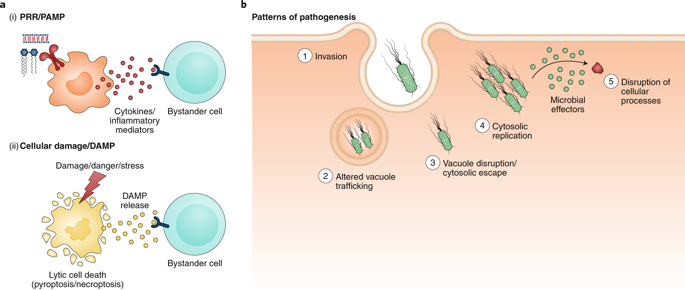当前位置:
X-MOL 学术
›
Nat. Microbiol.
›
论文详情
Our official English website, www.x-mol.net, welcomes your
feedback! (Note: you will need to create a separate account there.)
Effector-triggered immunity and pathogen sensing in metazoans.
Nature Microbiology ( IF 20.5 ) Pub Date : 2019-12-19 , DOI: 10.1038/s41564-019-0623-2 Natasha Lopes Fischer 1 , Nawar Naseer 1 , Sunny Shin 1 , Igor E Brodsky 2
Nature Microbiology ( IF 20.5 ) Pub Date : 2019-12-19 , DOI: 10.1038/s41564-019-0623-2 Natasha Lopes Fischer 1 , Nawar Naseer 1 , Sunny Shin 1 , Igor E Brodsky 2
Affiliation

|
Microbial pathogens possess an arsenal of strategies to invade their hosts, evade immune defences and promote infection. In particular, bacteria use virulence factors, such as secreted toxins and effector proteins, to manipulate host cellular processes and establish a replicative niche. Survival of eukaryotic organisms in the face of such challenge requires host mechanisms to detect and counteract these pathogen-specific virulence strategies. In this Review, we focus on effector-triggered immunity (ETI) in metazoan organisms as a mechanism for pathogen sensing and distinguishing pathogenic from non-pathogenic microorganisms. For the purposes of this Review, we adopt the concept of ETI formulated originally in the context of plant pathogens and their hosts, wherein specific host proteins 'guard' central cellular processes and trigger inflammatory responses following pathogen-driven disruption of these processes. While molecular mechanisms of ETI are well-described in plants, our understanding of functionally analogous mechanisms in metazoans is still emerging. In this Review, we present an overview of ETI in metazoans and discuss recently described cellular processes that are guarded by the host. Although all pathogens manipulate host pathways, we focus primarily on bacterial pathogens and highlight pathways of effector-triggered immune defence that sense disruption of core cellular processes by pathogens. Finally, we discuss recent developments in our understanding of how pathogens can evade ETI to overcome these host adaptations.
中文翻译:

后生动物中效应物触发的免疫和病原体感知。
微生物病原体拥有一系列策略来入侵宿主、逃避免疫防御和促进感染。特别是,细菌使用毒力因子,如分泌的毒素和效应蛋白,来操纵宿主细胞过程并建立复制生态位。面对这种挑战,真核生物的生存需要宿主机制来检测和抵消这些病原体特异性毒力策略。在这篇综述中,我们将重点关注后生动物中的效应触发免疫 (ETI) 作为病原体感知和区分致病微生物与非致病微生物的机制。出于本综述的目的,我们采用最初在植物病原体及其宿主背景下制定的 ETI 概念,其中特定的宿主蛋白“保护” 中枢细胞过程并在病原体驱动破坏这些过程后引发炎症反应。虽然 ETI 的分子机制在植物中得到了很好的描述,但我们对后生动物中功能相似机制的理解仍在不断涌现。在这篇综述中,我们概述了后生动物中的 ETI,并讨论了最近描述的由宿主保护的细胞过程。尽管所有病原体都操纵宿主途径,但我们主要关注细菌病原体并强调效应触发的免疫防御途径,这些途径感知病原体对核心细胞过程的破坏。最后,我们讨论了我们对病原体如何逃避 ETI 以克服这些宿主适应的理解的最新进展。虽然 ETI 的分子机制在植物中得到了很好的描述,但我们对后生动物中功能相似机制的理解仍在不断涌现。在这篇综述中,我们概述了后生动物中的 ETI,并讨论了最近描述的由宿主保护的细胞过程。尽管所有病原体都操纵宿主途径,但我们主要关注细菌病原体并强调效应触发的免疫防御途径,这些途径感知病原体对核心细胞过程的破坏。最后,我们讨论了我们对病原体如何逃避 ETI 以克服这些宿主适应的理解的最新进展。虽然 ETI 的分子机制在植物中得到了很好的描述,但我们对后生动物中功能相似机制的理解仍在不断涌现。在这篇综述中,我们概述了后生动物中的 ETI,并讨论了最近描述的由宿主保护的细胞过程。尽管所有病原体都操纵宿主途径,但我们主要关注细菌病原体并强调效应触发的免疫防御途径,这些途径感知病原体对核心细胞过程的破坏。最后,我们讨论了我们对病原体如何逃避 ETI 以克服这些宿主适应的理解的最新进展。我们概述了后生动物中的 ETI,并讨论了最近描述的由宿主保护的细胞过程。尽管所有病原体都操纵宿主途径,但我们主要关注细菌病原体并强调效应触发的免疫防御途径,这些途径感知病原体对核心细胞过程的破坏。最后,我们讨论了我们对病原体如何逃避 ETI 以克服这些宿主适应的理解的最新进展。我们概述了后生动物中的 ETI,并讨论了最近描述的由宿主保护的细胞过程。尽管所有病原体都操纵宿主途径,但我们主要关注细菌病原体并强调效应触发的免疫防御途径,这些途径感知病原体对核心细胞过程的破坏。最后,我们讨论了我们对病原体如何逃避 ETI 以克服这些宿主适应的理解的最新进展。
更新日期:2019-12-19
中文翻译:

后生动物中效应物触发的免疫和病原体感知。
微生物病原体拥有一系列策略来入侵宿主、逃避免疫防御和促进感染。特别是,细菌使用毒力因子,如分泌的毒素和效应蛋白,来操纵宿主细胞过程并建立复制生态位。面对这种挑战,真核生物的生存需要宿主机制来检测和抵消这些病原体特异性毒力策略。在这篇综述中,我们将重点关注后生动物中的效应触发免疫 (ETI) 作为病原体感知和区分致病微生物与非致病微生物的机制。出于本综述的目的,我们采用最初在植物病原体及其宿主背景下制定的 ETI 概念,其中特定的宿主蛋白“保护” 中枢细胞过程并在病原体驱动破坏这些过程后引发炎症反应。虽然 ETI 的分子机制在植物中得到了很好的描述,但我们对后生动物中功能相似机制的理解仍在不断涌现。在这篇综述中,我们概述了后生动物中的 ETI,并讨论了最近描述的由宿主保护的细胞过程。尽管所有病原体都操纵宿主途径,但我们主要关注细菌病原体并强调效应触发的免疫防御途径,这些途径感知病原体对核心细胞过程的破坏。最后,我们讨论了我们对病原体如何逃避 ETI 以克服这些宿主适应的理解的最新进展。虽然 ETI 的分子机制在植物中得到了很好的描述,但我们对后生动物中功能相似机制的理解仍在不断涌现。在这篇综述中,我们概述了后生动物中的 ETI,并讨论了最近描述的由宿主保护的细胞过程。尽管所有病原体都操纵宿主途径,但我们主要关注细菌病原体并强调效应触发的免疫防御途径,这些途径感知病原体对核心细胞过程的破坏。最后,我们讨论了我们对病原体如何逃避 ETI 以克服这些宿主适应的理解的最新进展。虽然 ETI 的分子机制在植物中得到了很好的描述,但我们对后生动物中功能相似机制的理解仍在不断涌现。在这篇综述中,我们概述了后生动物中的 ETI,并讨论了最近描述的由宿主保护的细胞过程。尽管所有病原体都操纵宿主途径,但我们主要关注细菌病原体并强调效应触发的免疫防御途径,这些途径感知病原体对核心细胞过程的破坏。最后,我们讨论了我们对病原体如何逃避 ETI 以克服这些宿主适应的理解的最新进展。我们概述了后生动物中的 ETI,并讨论了最近描述的由宿主保护的细胞过程。尽管所有病原体都操纵宿主途径,但我们主要关注细菌病原体并强调效应触发的免疫防御途径,这些途径感知病原体对核心细胞过程的破坏。最后,我们讨论了我们对病原体如何逃避 ETI 以克服这些宿主适应的理解的最新进展。我们概述了后生动物中的 ETI,并讨论了最近描述的由宿主保护的细胞过程。尽管所有病原体都操纵宿主途径,但我们主要关注细菌病原体并强调效应触发的免疫防御途径,这些途径感知病原体对核心细胞过程的破坏。最后,我们讨论了我们对病原体如何逃避 ETI 以克服这些宿主适应的理解的最新进展。






























 京公网安备 11010802027423号
京公网安备 11010802027423号